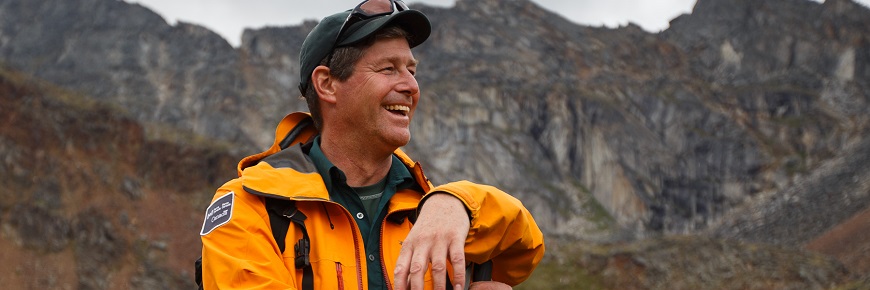
My return to Superior country
Lake Superior National Marine Conservation Area
by Doug Tate
Now don’t get me wrong, the word “superior” can be applied to much of Canada; I can attest to that thanks in large part to my career with Parks Canada. But the title seems fitting, since my first Parks Canada job was on Lake Superior, and I have recently returned to work at Lake Superior National Marine Conservation Area.
After finishing my B.Sc. in wildlife biology and having been in school for 18 years straight (excluding summers) it was time for a break. Thus began my ‘year of no income’ in which I volunteered with the US Fish and Wildlife Service in California, and spent half a year assisting on a research project in Venezuela. Upon returning home (yes, my parents’ house) it was time to find a real job, as they say. After a few months of pumping gas, I landed a seasonal interpreter (now heritage presenter) position at Pukaskwa National Park. That was a fun summer, introducing park visitors to the natural wonders of Lake Superior’s shore, and I returned for two more seasons. In winter, I volunteered at Pacific Rim and worked at Georgian Bay Islands national parks, giving me exposure to more of Canada’s great coastlines. However, the lure of doing science was strong, and I opted to return to university for a Master’s program, funded in large part by Parks Canada.
Following graduation, I worked for one summer as a park warden in St. Lawrence Islands National Park (now Thousand Islands) before getting the opportunity to head north, to work as a Conservation Biologist in Nahanni National Park Reserve. It was a great fit for me – lots of time in the field, travel in jet boats, helicopters and float planes, hiking on alpine plateaux, and canoeing on the stunning South Nahanni River. For anyone who thinks Canada’s Northwest Territories are all flat, treeless tundra, Nahanni is a place to prove them wrong. With the country’s deepest river canyons, world-renowned rock climbing faces, a waterfall twice the height of Niagara, hot springs, and cave passages stretching kilometres underground, the geology and hydrology is stunning. The region’s plant and animal biodiversity is surprising for the northern latitude as well.
Nahanni had no formal ecological integrity monitoring plan in place when I arrived, and there was lots of exploring still to be done. That was perhaps the highlight for me: being part of developing the park program, and making ecological discoveries. In my fifteen plus years at Nahanni many bird species were added to the park list, and I helped to design and implement research projects to assess the size and genetic diversity of Grizzly Bears, to map the distribution of Bull Trout, and to verify species classification and status of the endemic Nahanni Aster (Symphyotrichum nahanniense), to name just a few.
Those bigger projects were collaborations, and the chance to work with a range of knowledgeable and talented scientists – including people from academia, non-governmental agencies, territorial and other federal government departments, private consultants – was another great aspect of the job; it was always a learning experience. But I also learned much from the local people: working with park staff from the area, travelling with band members participating on research projects and staff trips, and having discussions with members of the Nahʔą Dehé Consensus Team (the park’s cooperative management body representing both Parks Canada and the Dehcho First Nations). The elders and harvesters on this team help guide park management decisions in all areas, including the research and monitoring which was the focus of my work.
The decision to leave the north was not an easy one, but the opportunity to work at another new Parks Canada site developing its resource management programs was appealing, and the move fit for family and personal reasons, as well. I felt welcomed at Lake Superior National Marine Conservation Area, I have enjoyed my first explorations of this site and look forward to learning more about the places and people of the region.
Back to shoreLINES
- Date modified :